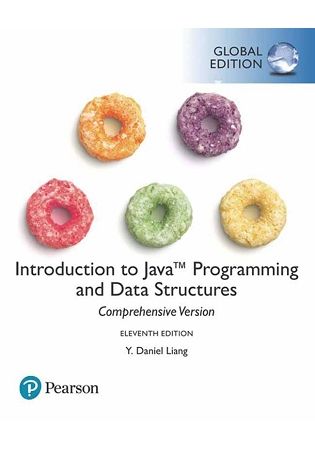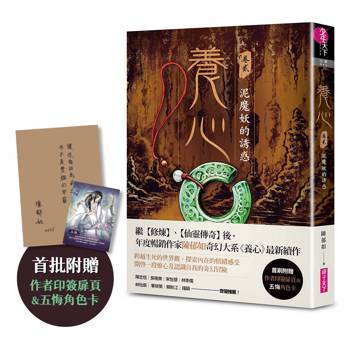This text is intended for a 1-semester CS1 course sequence. The Brief Version contains the first 18 chapters of the Comprehensive Version. The first 13 chapters are appropriate for preparing the AP Computer Science exam.
For courses in Java Programming.
A fundamentals-first introduction to basic programming concepts and techniques
Designed to support an introductory programming course, Introduction to Java Programming and Data Structuresteaches you concepts of problem-solving and object-orientated programming using a fundamentals-first approach. Beginner programmers learn critical problem-solving techniques then move on to grasp the key concepts of object-oriented, GUI programming, data structures, and Web programming. This course approaches Java GUI programming using JavaFX, which has replaced Swing as the new GUI tool for developing cross-platform-rich Internet applications and is simpler to learn and use. The 11th edition has been completely revised to enhance clarity and presentation, and includes new and expanded content, examples, and exercises.
本書特色
New to this edition
About the Book
1. The title has been changed to Introduction to Java Programming and Data Structures, Comprehensive to reflect its use in data structures courses based on a practical approach to introduce design, implement, and use data structures that covers all topics in a typical data structures course.
2. UPDATED to Java 8 and 9. Examples and exercises are improved and simplified by using the new features in Java 8 and 9.
3. More examples and exercises in the data structures chapters use Lambda expressions to simplify coding.
4. Chapter 30 is brand new to introduce aggregate operations for collection streams.
Content Updates
1. The GUI chapters are updated to JavaFX 8. The examples are revised. The user interfaces in the examples and exercises are now resizable and displayed in the center of the window.
2. Chapter 13 introduces default and static methods
3. Chapter 15 covers inner classes, anonymous inner classes, and lambda expressions using practical examples
4. Chapter 20 introduces the forEach method as a simple alternative to the foreach loop for applying an action to each element in a collection.
5. Chapters 24-29 Use the default methods for interfaces in Java 8 to redesign MyList, MyArrayList, MyLinkedList, Tree, BST, AVLTree, MyMap, MyHashMap, MySet, MyHashSet, Graph, UnweightedGraph, and WeightedGraph
6. Chapter 31 introduces FXML and the Scene Buildervisual tools
| FindBook |
有 4 項符合
INTRODUCTION TO JAVA PROGRAMMING: COMPREHENSIVE VERSION 11/E (GE)的圖書 |
| 圖書館借閱 |
| 國家圖書館 | 全國圖書書目資訊網 | 國立公共資訊圖書館 | 電子書服務平台 | MetaCat 跨館整合查詢 |
| 臺北市立圖書館 | 新北市立圖書館 | 基隆市公共圖書館 | 桃園市立圖書館 | 新竹縣公共圖書館 |
| 苗栗縣立圖書館 | 臺中市立圖書館 | 彰化縣公共圖書館 | 南投縣文化局 | 雲林縣公共圖書館 |
| 嘉義縣圖書館 | 臺南市立圖書館 | 高雄市立圖書館 | 屏東縣公共圖書館 | 宜蘭縣公共圖書館 |
| 花蓮縣文化局 | 臺東縣文化處 |
|
|
圖書介紹 - 資料來源:博客來 評分:
圖書名稱:INTRODUCTION TO JAVA PROGRAMMING: COMPREHENSIVE VERSION 11/E (GE)
內容簡介
目錄
1. Introduction to Computers, Programs, and Java
2. Elementary Programming
3. Selections
4. Mathematical Functions, Characters, and Strings
5. Loops
6. Methods
7. Single-Dimensional Arrays
8. Multidimensional Arrays
9. Objects and Classes
10. Object-Oriented Thinking
11. Inheritance and Polymorphism
12. Exception Handling and Text I/O
13. Abstract Classes and Interfaces
14. JavaFX Basics
15. Event-Driven Programming and Animations
16. JavaFX UI Controls and Multimedia
17. Binary I/O
18. Recursion
19. Generics
20. Lists, Stacks, Queues, and Priority Queues
21. Sets and Maps
22. Developing Efficient Algorithms
23. Sorting
24. Implementing Lists, Stacks, Queues, and Priority Queues
25. Binary Search Trees
26. AVL Trees
27. Hashing
28. Graphs and Applications
29. Weighted Graphs and Applications
30. Aggregate Operations for Collection Streams
Appendixes
Appendix A Java Keywords
Appendix B The ASCII Character Set
Appendix C Operator Precedence Chart
Appendix D Java Modifiers
Appendix E Special Floating-Point Values
Appendix F Number Systems
Appendix G Bitwise Operations
Appendix H Regular Expressions
Appendix I Enumerated types
Bonus Chapters 31–44 are available from the Companion Website at www.pearsonhighered.com/liang:
31. Advanced JavaFX and FXML
32. Multithreading and Parallel Programming
33. Networking
34. Java Database Programming
35. Advanced Database Programming
36. Internationalization
37. Servlets
38. JavaServer Pages
39. JavaServer Faces
40. RMI
41. Web Services
42. 2-4 Trees and B-Trees
43. Red-Black Trees
44. Testing Using JUnit
2. Elementary Programming
3. Selections
4. Mathematical Functions, Characters, and Strings
5. Loops
6. Methods
7. Single-Dimensional Arrays
8. Multidimensional Arrays
9. Objects and Classes
10. Object-Oriented Thinking
11. Inheritance and Polymorphism
12. Exception Handling and Text I/O
13. Abstract Classes and Interfaces
14. JavaFX Basics
15. Event-Driven Programming and Animations
16. JavaFX UI Controls and Multimedia
17. Binary I/O
18. Recursion
19. Generics
20. Lists, Stacks, Queues, and Priority Queues
21. Sets and Maps
22. Developing Efficient Algorithms
23. Sorting
24. Implementing Lists, Stacks, Queues, and Priority Queues
25. Binary Search Trees
26. AVL Trees
27. Hashing
28. Graphs and Applications
29. Weighted Graphs and Applications
30. Aggregate Operations for Collection Streams
Appendixes
Appendix A Java Keywords
Appendix B The ASCII Character Set
Appendix C Operator Precedence Chart
Appendix D Java Modifiers
Appendix E Special Floating-Point Values
Appendix F Number Systems
Appendix G Bitwise Operations
Appendix H Regular Expressions
Appendix I Enumerated types
Bonus Chapters 31–44 are available from the Companion Website at www.pearsonhighered.com/liang:
31. Advanced JavaFX and FXML
32. Multithreading and Parallel Programming
33. Networking
34. Java Database Programming
35. Advanced Database Programming
36. Internationalization
37. Servlets
38. JavaServer Pages
39. JavaServer Faces
40. RMI
41. Web Services
42. 2-4 Trees and B-Trees
43. Red-Black Trees
44. Testing Using JUnit
|











